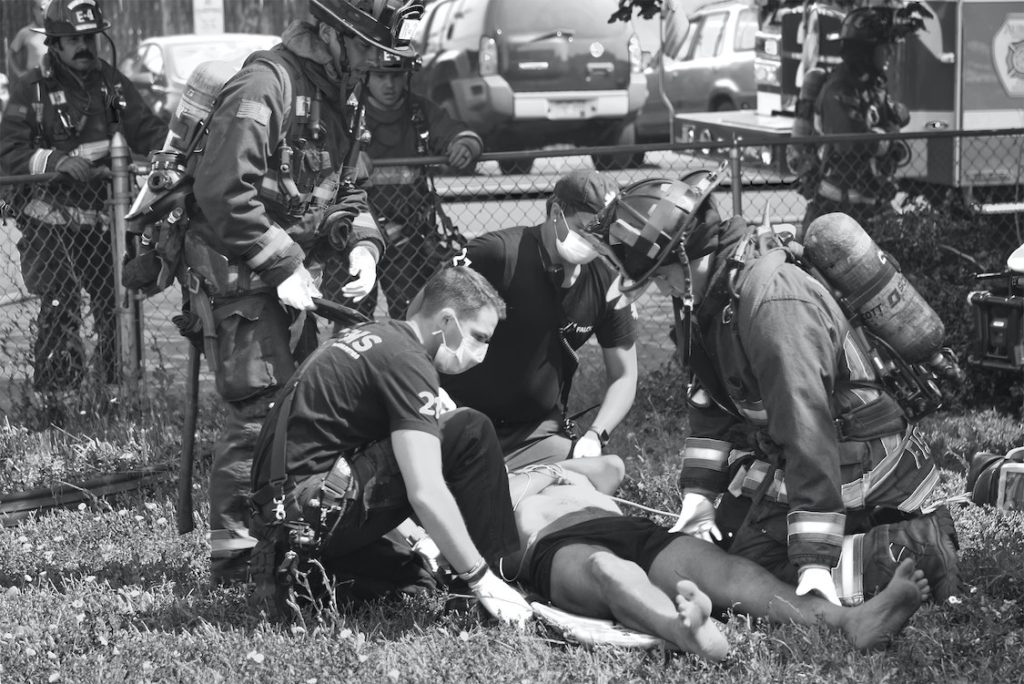Emergency Medical Services personnel (EMS) have been on the front lines of the COVID health pandemic for 18 months now, with no end in sight. These key healthcare providers continue to adapt to an ever-changing work environment and thus far have maintained a high level of care.

If you’re thinking of entering the field of EMS, know this: The need is greater than ever. That given, what should you know about EMS in the era of COVID? Below are thoughts from the experts here at The National Center for Outdoor & Adventure Education (NCOAE), where we offer a number of training options to prepare future EMTs for what lies ahead.
To get us started, let’s take a look at PPEs.
Personal Protective Equipment (PPE): For years most EMS providers considered “PPE” to mean “Exam Gloves.” No longer. Today, you’ll most likely be required to wear an N-95 respirator and eye protection for an entire 12-hour shift. You can probably also add a gown and potentially additional layers to that ensemble. It’s hot and uncomfortable and no one enjoys it. But we’ve shown it can be done, and that it’s being done to good effect.
Educating the public: There has been a tremendous amount of confusing and even intentionally misleading information regarding the COVID health pandemic. EMS providers are constantly bombarded with questions from the public, including patients, families, and random people on the street.
EMS personnel are a trusted source and have had to take on a public health role. Many patients were initially too afraid of catching the Corona virus to go to the hospital. Others would refuse mask mandates or became angry about visitation policies. EMS providers learned to provide accurate, factual information to help everyone through.
An increased need for EMS: Following the initial lockdown, there was a brief slowdown in EMS calls and Emergency Department (ED) visits. That respite did not last very long. Hospitals in many regions of the country are again filled to capacity, leaving patients waiting for a bed, sometimes for days, in the ED. This frequently leaves EMS personnel standing in the hallway with a patient on their stretcher, waiting for a bed. By the same token, ambulances crews waiting for a bed at the ED aren’t available to take new 911 calls.
Some services have adapted to this backlog by creating their own EMS waiting rooms in the hallways. One or two EMTs or paramedics monitor six to eight patients in a holding area in the ED until beds become available. This gets ambulances and crews back out on the street for the next emergency.
Shortage of providers: It seems that most of the nation’s healthcare system is short staffed at the moment. That includes EMS. Agencies can’t hire and train new employees fast enough. However, that could be great news if you’re looking for a job right now. Health agencies are currently offering bonuses, money for education, and higher salaries.
Increased public awareness: EMS has traditionally been an underappreciated career choice. It’s relatively new on the scene and not nearly as well established as the fire or law enforcement fields. However, the COVID health pandemic has brought to the forefront what it is exactly that EMS providers do on a daily basis. Hopefully, this increased awareness will attract the next generation of EMS professionals and prompt health agencies and local governments to invest more in those professionals.
If you’re interested in a career as an Emergency Medical Technician (EMT), consider enrolling in an EMT training program that satisfies eligibility requirements for the National Registry of Emergency Medical Technicians and state EMT certification exams.
Here at NCOAE, we offer a 21-day Hybrid ‘Intensive’ EMT certification training course (hybridmeaning, the course includes 10-days of virtual instructor led training that you can participate in from home, along with 11-days of hands-on, practical skills training at our campus in North Carolina), and a fully in person, 21-day intensive EMT training that also satisfies eligibility requirements for the National Registry and state EMT certification exams.
For more information, visit the Emergency Medicine Training section of our website, or call us at (910) 399-8090. We’re available between 8:30 a.m. — 4:30 p.m. Eastern Time, and we’re always be happy to talk with you about your interest in EMT training.
TALK TO US
Have any further questions about our courses, what you’ll learn, or what else to expect? Contact us, we’re here to help!
Leave a comment